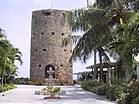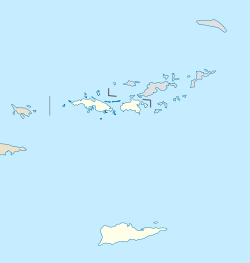
Back Charlotte Amalie Afrikaans Ceorlette Amaliaburh ANG شارلوت أمالي Arabic شارلوت امالى ARZ Carlota Amalia AST Şarlotta-Amaliya Azerbaijani Шарлота-Амалія Byelorussian Шарлот Амалія BE-X-OLD Шарлот Амали Bulgarian Charlotte Amalie (Inizi Gwerc'h) Breton
Charlotte Amalie | |
|---|---|
|
Top: Lookout View of Charlotte Amalie; Upper Middle: Rothschild Francis Market Square, Fort Christian; Middle: Villa Nottman, Blackbeard's Castle; Lower Middle: Legislature Building (Capitol Building), VI Alexander A Farrelly Justice Complex and Ron De Lugo US Federal Building on the far right. | |
Location within the United States Virgin Islands | |
| Coordinates: 18°21′N 64°57′W / 18.350°N 64.950°W | |
| Country | |
| Territory | |
| District | Saint Thomas-Saint John |
| Island | Saint Thomas |
| Subdistrict(s) | Charlotte Amalie, Northside |
| Government | |
| • Mayor | None[1] |
| Area | |
• Town | 3.14 km2 (1.213 sq mi) |
| • Urban | 8.7 km2 (3.36 sq mi) |
| Population (2020)[2] | |
• Town | 8,194 |
| • Density | 2,600/km2 (6,800/sq mi) |
| • Urban | 14,477 (subdistrict) |
| Time zone | AST (UTC-4) |
| ZIP code(s) | 00801, 00802, 00803, 00804 |
| Area code | 340 |
| Major routes | |
Charlotte Amalie (/ˈʃɑːrlət əˈmɑːli(ə)/ SHAR-lət ə-MAH-lee(-ə)),[3] located on St. Thomas, is the capital and the largest town of the United States Virgin Islands. It is the anchor of the subdistrict (or "the City") of Charlotte Amalie that is composed of the town of Charlotte Amalie, the census-designated place (CDP) of Charlotte Amalie West, and the CDP of Charlotte Amalie East.[4] It was founded in 1666 as Taphus (meaning 'tap house' or 'beer hall' in Danish).[5] In 1691, the town was renamed to Charlotte Amalie after the Danish queen Charlotte Amalie of Hesse-Kassel (1650–1714). It has a deep-water harbor that was once a haven for pirates and is now one of the busiest ports of call for cruise ships in the Caribbean, with about 1.5 million-plus cruise ship passengers landing there annually. Protected by Hassel Island, the harbor has docking and fueling facilities, machine shops, and shipyards and was a U.S. submarine base until 1966. The town has been inhabited for centuries. When Christopher Columbus arrived in 1493, the area was inhabited by Caribs, Arawaks, Ciboney and Taíno native peoples. It is on the southern shore at the head of Saint Thomas Harbor. In 2020 the subdistrict of Charlotte Amalie had a population of 14,477[6] which makes it the most densely populated area in the Virgin Islands Archipelago with the town of Charlotte Amalie as the anchor of "the City". Hundreds of ferries and yachts pass by the town each week.
The town is known for its Danish colonial architecture, building structure and history. Dozens of streets and places throughout the town have Danish names. Charlotte Amalie has buildings of historical importance including St. Thomas Synagogue, the second oldest synagogue in the western hemisphere and oldest under the United States flag,[7] and Frederick Lutheran Church. The town has a long history of pirates, especially myths of Bluebeard, and facts and stories of Blackbeard (Edward Teach). In the 17th century, the Danes built both Blackbeard's Castle and Bluebeard's Castle attributed to the pirates. Blackbeard's Castle is a U.S. National Historic Landmark. Another tourist attraction is Fort Christian, the oldest standing structure in the Virgin Islands Archipelago. A copy of the Liberty Bell and freed slave blowing a conch shell are in Emancipation Park, which is both a source of national pride and a tourist attraction.[8]

Downtown Charlotte Amalie is divided into three historical quarters, reflecting its Danish colonial past. These quarters are:
- Kongens Kvarter (King's Quarter): This area contains many historic government buildings, Charlotte Amalie harbor defense structures and landmarks. It is central to administrative activities during the colonial period and today. Government House, the Virgin Islands Capitol Building, Superior Court of the Virgin Islands (in the Alexander A Farrelly Justice Complex) and United States District Court of the Virgin Islands (in the Ron Delugo Federal Building), Emancipation Garden as well as Fort Christian are located in this quarter.
- Dronningens Kvarter (Queen's Quarter): This quarter features residential areas as well as the downtown commercial shopping district.
- Kronprinsens Kvarter (Crown Prince's Quarter): This area historically housed various community as well as merchant activities like the sale of slaves and produces at the Rothchild Francis Market Square. It also includes a mix of residential and business spaces.
The transitions between the quarters in downtown Charlotte Amalie are not always clearly marked. However, the best way to identify these changes is by following Virgin Islands Route 308. This road, which passes through all three quarters, provides a practical guide to their boundaries.
- In Kongens Kvarter, Route 308 is known as Nørre Gade (English: North Street). It begins at the easternmost side of the quarter, at the intersection with Bjerge Gade (English: Mountain Street) Route 314. Here, the road is a two-lane street.
- As you enter Dronningens Kvarter, the road becomes Dronningens Gade (English: Queen Street) and transitions into a one-way street heading west.
- In Kronprinsens Kvarter, Route 308 changes its name to Kronprinsens Gade (English: Crown Prince Street) and returns to being a two-lane road.
Finally, as Route 308 exits downtown Charlotte Amalie, it becomes Harwood Highway, marking the end of the historic downtown district at the west end.
Downtown Charlotte Amalie is primarily bordered on the south by Virgin Islands Highway 30, commonly known as Veterans Drive or the Waterfront Highway. The northern boundary is less clearly defined, but a useful rule of thumb is that once the street names transition from Danish to English, you are likely outside of downtown Charlotte Amalie as downtown Charlotte Amalie is the only area of the island of St. Thomas with street names in Danish.

Frenchtown is a distinctive neighborhood and fishing community within the town limits of Charlotte Amalie, located southwest of downtown and just south of Highway 30. While downtown Charlotte Amalie is known for its Danish street names, Frenchtown stands out with its French-named streets, reflecting its rich French-Caribbean heritage. This charming area is close to the city center yet has a unique identity of its own. Originally settled by French immigrants from the island of Saint-Barthélemy in the late 19th and early 20th centuries, it has retained a strong French-Caribbean influence that is evident in its traditions, cuisine, and way of life. Frenchtown is known for its vibrant French heritage, with many families in the area tracing their ancestry to Saint-Barthélemy. The community celebrates French traditions, including culinary and religious practices. Historically, Frenchtown was a fishing village, and fishing remains an important part of its identity.
Like the rest of the U.S. Virgin Islands, Charlotte Amalie has no local government and is directly administered by the territorial government. However, it has boundaries defined by the Virgin Islands Code and is recognized as a town by the U.S. Census Bureau.[9]
- ^ "Puerto Rico and the Outlying Areas" (PDF). Geographic Areas Reference Manual. Bureau of the Census. 1994. pp. 38–40. Retrieved May 9, 2023.
The only functioning governmental unit in the Virgin Islands is the territorial government.
- ^ "Table 1. Population of the United States Virgin Islands : 2010 and 2020" (PDF). United States Census Bureau. Retrieved November 25, 2024.
- ^ "How to Pronounce Charlotte Amalie (Real Life Examples!)". YouTube.
- ^ "United States Census Bureau" (PDF).
- ^ "The History of St. Thomas, US Virgin Islands". Stthomasusvi.thebeach.vi. Retrieved January 11, 2014.
- ^ "Table 1. Population of the United States Virgin Islands : 2010 and 2020" (PDF). United States Census Bureau. Retrieved November 25, 2024.
- ^ "synagogue.vi". synagogue.vi. Retrieved December 8, 2024.
- ^ "St. Thomas Attractions: Historic Sites in Charlotte Amalie (Kongen's Quarter)". Vinow.com. Retrieved January 11, 2014.
- ^ "Puerto Rico and the Outlying Areas" (PDF). Geographic Areas Reference Manual. Bureau of the Census. 1994. pp. 38–41. Retrieved May 9, 2023.
The only functioning governmental unit in the Virgin Islands is the territorial government.







